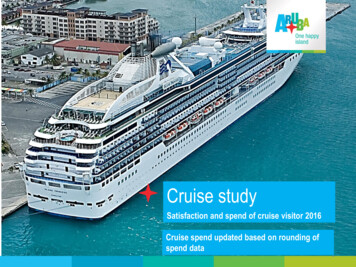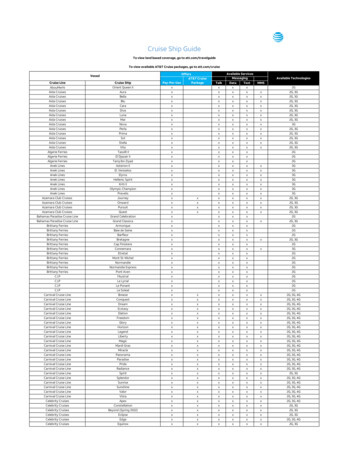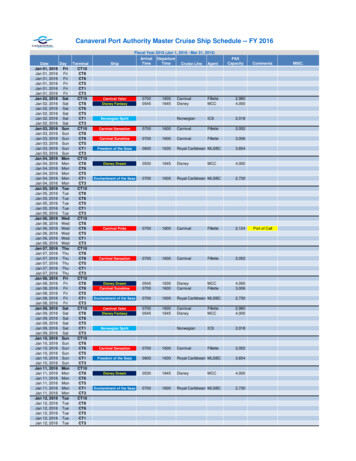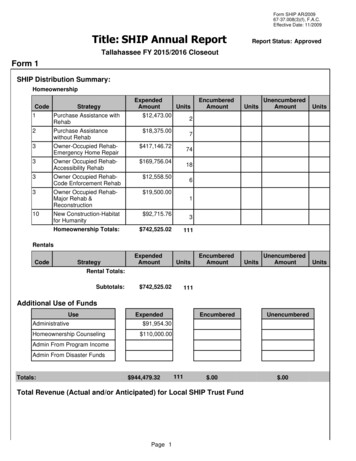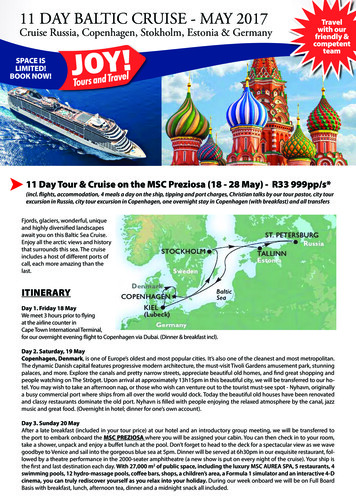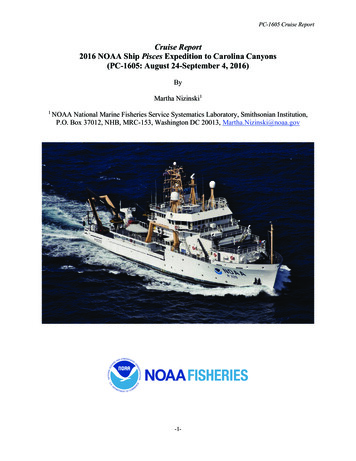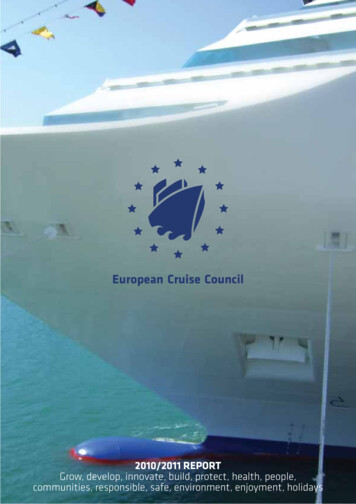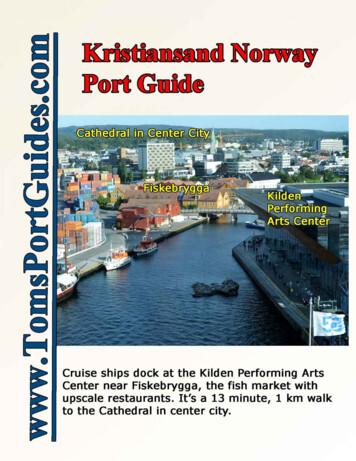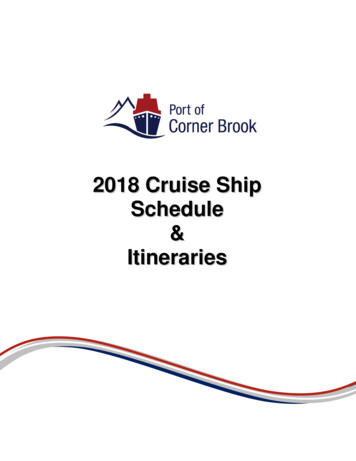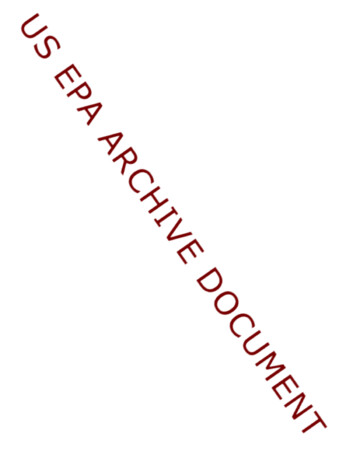
Transcription
This document is a portion of the Cruise Ship Discharge Assessment Report (AssessmentReport), published on December 29, 2008. The reference number is EPA 842-R-07-005.The entire Assessment Report can be accessed athttp://www.epa.gov/owow/oceans/cruise ships/disch assess.html.Cruise Ship Discharge Assessment ReportSection 6: Hazardous WasteDecember 29, 2008
December 29, 2008Section 6: Hazardous WasteHazardous waste is a subset of “solid waste,” and is a waste that contains hazardous constituentsthat can be liquid, solid, semisolid, or contained gas. On most cruise ships, the hazardous wastegenerated onboard is stored onboard until the wastes can be off-loaded for recycling or disposal.Hazardous waste that is off-loaded for disposal in the United States is handled in accordancewith RCRA requirements, and must be sent to a licensed hazardous waste Treatment, Storage,and Disposal Facility.This section discusses the current state of information about hazardous waste, the laws regulatinghazardous waste from vessels, how hazardous waste is managed on cruise ships, the potentialenvironmental impacts of cruise ship hazardous waste, and federal actions taken to addresshazardous waste from cruise ships. The conclusion of this section lists a wide range of optionsand alternatives that could be considered when addressing hazardous waste from cruise ships.6.1 What is RCRA hazardous waste and how much is landed by cruise ships to theUnited States?Under federal law, “hazardous waste” is a subset of “solid waste.” The regulationsimplementing the Resource Conservation Recovery Act (RCRA) establish the criteria fordefining “hazardous waste” with two basic approaches: a solid waste is a hazardous waste if it iseither a waste that appears on one of the four hazardous waste lists (i.e., F-List, K-List, P-List, orU-List); or the solid waste exhibits at least one of four hazardous characteristics (ignitability,corrosivity, reactivity, or toxicity). Once a waste is identified as a hazardous waste, any personwho generates or manages the hazardous waste must comply with all applicable state and federalregulations regarding its management. Hazardous wastes need to be stored, treated, and disposedin a manner so as to minimize the risks to human health and the environment.The universe of hazardous waste is diverse – it is a waste that contains hazardous constituentsthat can be liquid, solid, semisolid, or contained gas. The universe of wastes generated as aresult of daily cruise ship activities is diverse as well. Cruise ship activities such as photoprocessing, dry cleaning, and equipment cleaning can produce hazardous waste containing awide range of substances such as water with perchlorethylene from dry cleaning machines,hydrocarbons, chlorinated hydrocarbons, heavy metals, and solvents. Additional wastesgenerated on cruise ships that may be hazardous include paint waste, aerosol liquid waste fromthe crushing of aerosol cans, some incinerator ash, fluorescent and mercury vapor light bulbs,various types of batteries, and unused or outdated pharmaceuticals. Table 6-1 identifies differenttypes of wastes generated on cruise ships that are, or may be, hazardous. This is only a list oftypical wastes, and ultimately it is the responsibility of the person generating the waste (i.e., shipowner and/or operator) to make this determination and to comply with all applicableenvironmental requirements.6-1
December 29, 2008Table 6-1. Types of Potentially Hazardous Waste Generated Aboard Cruise ShipsWaste TypePhoto Processing Waste(including X-raydevelopment fluidwaste)Dry Cleaning WastesPrint Shop WastesPhotocopying and LaserPrinter CartridgesUsed Cleaners, Solvents,Paints, and ThinnersUsed or OutdatedPharmaceuticalsIncinerator AshFluorescent/MercuryVapor BulbsBatteriesDescriptionSpent fixer, spent cartridges, expired film, and silver flake. The fixer removes unexposedsilver compounds from the film during the developing process. Though silver-bearing wasteis typically hazardous waste under RCRA due to silver content, RCRA regulations at 40 CFR266.70, which apply to materials recycled to recover economically significant amounts ofcertain precious metals, including silver, do not include all of the requirements applicable toother types of hazardous wastes generally.Dry cleaning units produce a small volume of waste from the bottoms of the internalrecovery stills and filter media. This waste comprises dirt, oils, filter material, and spentsolvent. The spent solvent is a chlorinated solvent called perchlorethylene (perc) and must bemanaged as a hazardous waste.Printing solvents, inks, and cleaners may contain hydrocarbons, chlorinated hydrocarbons,and heavy metals.Spent or discarded cartridges, inks, and toner materials are not typically defined as hazardousunder the federal RCRA program, but may be hazardous waste under some authorized stateprograms.Degreasing materials are a common element of maintenance onboard vessels;tetrachloroethylene is used for metal-degreasing.Cruise ships have pharmaceuticals based on the ship’s itinerary and the demographics of thepassenger base. Inventory that is discarded because it is off specification or has exceededshelf life may qualify as hazardous waste.Incinerator ash may contain constituents, such as heavy metals, in concentrations that wouldclassify the ash as hazardous waste under RCRA.These bulbs contain small amounts of mercury, and therefore lamps containing these types ofbulbs might qualify as RCRA hazardous waste when discarded. To promote the saferecycling and disposal of certain used lamps, EPA classifies these lamps as Universal Waste(40 CFR 273.5). For more information, /lamps.htm.Large batteries are used on tenders and standby generators; small batteries are used inflashlights and cameras. Other equipment on board may also require batteries. Four types ofbatteries typically used onboard cruise ships are: Lead-acid – Batteries that are wet, rechargeable, and usually six-celled typicallycontain a sponge lead anode, a lead dioxide cathode, and a sulfuric acid electrolytethat is corrosive. Nickel Cadmium (Nicad) – Batteries that are usually rechargeable and contain wetor dry potassium hydroxide as an electrolyte. The potassium hydroxide is corrosive;cadmium is a characteristic hazardous waste. Lithium – Batteries used for flashlights and portable electronic equipment. Somespent lithium batteries (specifically, lithium metal-sulfide batteries) may constitutehazardous wastes based on the “reactivity” criterion (D003). Alkaline – Batteries used for flashlights and other personal equipment. Thoughspent alkaline batteries are not considered hazardous waste under federalregulations, some alkaline batteries might be defined as hazardous waste under someauthorized states’ more stringent (or broader in scope) hazardous waste regulations(e.g., some states include tests, such as bioassay tests, to define hazardous waste,and some alkaline batteries may fail this test).Spent ExplosivesExplosives are used occasionally in small quantities for celebratory (e.g., theatricalproductions, parties, etc.) and/or emergency purposes (e.g., lifeboat flares). Discardedexplosives are managed as hazardous waste (ADEC, 2002).Sources: ADEC, 2000 and ADEC, 20026-2
December 29, 2008Limited information is available on the amount of hazardous waste that a cruise ship mightgenerate. Table 6-2 presents estimates of the hazardous waste generated in one week by theHolland America Lines fleet, consisting of 11 vessels in 2000, and by the Royal CaribbeanCruises Ltd. fleet, consisting of 17 vessels in 1999. The information provided in Table 6-2identifies specific hazardous waste materials that result from cruise ship activities. It is possiblethat these estimates may not be representative of the cruise ship fleets at this time. According tothe U.S. General Accounting Office (GAO) Report (2000), some of the larger cruise shipcompanies reported taking actions to reduce the amounts of hazardous waste onboard. Thesecruise ship companies reported replacing hazardous chemicals with non-hazardous ones, andimplementing procedures to improve the collection and disposal of waste from hazardousmaterials that cannot be replaced and must still be used. Table 6-3 presents more currentestimates of waste measured across all of Carnival Corporation’s operating lines and shipsaccording to their reports.Table 6-2. Estimates of Hazardous Waste Generated Per Week OnboardCruise Ship FleetsPhoto wastesHolland AmericaLines Fleet(11 Vessels)Amount Generatedin 20002262 gallons/weekRoyal CaribbeanCruises Ltd Fleet(17 vessels)Amount Generatedin 19991300 gallons/weekDiscarded and expired chemicals1735 lbs/week2050 lbs/weekMedical Waste45 lbs/week80 lbs/weekBatteries75 lbs/week580 lbs/week1Fluorescent Lights153 lbs/week270 lbs/weekExplosives6 lbs/week12 lbs/weekSpent paints and thinners213 gallons/week225 gallons/weekWaste TypeSource: The information above is the hazardous waste production per week by Holland AmericaLines Fleet, as reported in their 2000 Environmental Report (ADEC, 2002), and by RoyalCaribbean Cruises Ltd as reported in their 1999 Environmental Report “Save the Waves” (RoyalCaribbean Cruises Ltd, 1999).1Total amount of batteries includes alkaline/carbon zinc, alkaline/mercury, lead acid, NiCad,mercury, and lithium.6-3
December 29, 2008Table 6-3. Estimates of Hazardous Waste and Solid Waste GeneratedOnboard as Reported by Carnival Cruise LinesParameter2006 Measurement2005 MeasurementNotesSolid and Hazardous Waste0.0066 tonnes/ALBD 0.0077 tonnes/ALBD (1) and (2)(to shore)Solid Waste0.0079 tonnes/ALBD 0.0083 tonnes/ALBD (1) and (2)(to sea or incinerated)Source: Carnival Corporation & PLC, Environmental Management Report, Fiscal Year 2006NOTES:1. Rather than refer to measurements as Passenger Berth Days to normalize data by ship size/capacity,the more commonly referenced cruise industry indicator ALBD (Available Lower Berth Day) isused to normalize data by ship size/capacity.2. This parameter measures solid and hazardous waste disposal normalized by ALBD. Hazardouswaste disposal is normally less than 1% of total waste disposal. Hazardous waste is landed to shorefacilities. There are three methods for solid waste, namely disposal ashore, at sea, or incineratedwaste. According to Carnival Cruise Lines, the “at sea” or “incinerated waste” isdischarged/disposed in accordance with MARPOL and applicable laws and regulations; plastic isnot disposed at sea. Incinerated waste includes dry garbage, food waste, and sludge.In 2003, the California Environmental Protection Agency (Cal/EPA) convened a multi-agencyCruise Ship Environmental Task Force to evaluate the environmental practices and wastestreams of large passenger vessels (cruise ships). After gathering information from the cruiseindustry, the Task Force prepared a report to the California legislature. Regarding hazardouswaste implementation issues, the Task Force highlighted the differences between stationaryhazardous waste generators operating in California, and cruise ships that can operate inCalifornia but also off-load hazardous waste in other states or countries. The Task Force statedthat it would be impossible for inspectors to track the disposal path of all onboard-generatedhazardous waste without the cooperation of the cruise line. While the Task Force did notrecommend any specific additional requirements for cruise ships related to managing or trackinghazardous waste, they did suggest additional information gathering. The Task Force also saidthat after such information gathering, it may be necessary to promulgate regulations to clarifythat cruise ships operating in California are subject to the state hazardous waste managementrequirements in the same manner as other hazardous waste generators.6.2 What federal laws apply to hazardous waste on cruise ships?6.2.1 Clean Water ActAs noted earlier, the Clean Water Act (CWA) prohibits any person from discharging anypollutant from any point source into waters of the United States, except in compliance with aNational Pollutant Discharge Elimination System (NPDES) permit or otherwise authorized underthe Act. The term “point source” is defined to include a “vessel or other floating craft.” UnderCWA section 502(12)(b), the requirement for an NPDES permit applies to the addition of anypollutant from any point source “other than a vessel or other floating craft” in the contiguouszone or the ocean, i.e., outside the territorial seas. Whether a discharge is authorized under anNPDES permit affects applicability of RCRA; dissolved and solid materials in industrial6-4
December 29, 2008discharges which are point sources subject to NPDES permits are not “solid waste” under theRCRA statute and thus not “hazardous waste.” This only applies to materials once they havebeen discharged. Prior to being discharged pursuant to an NPDES permit, wastes remain subjectto RCRA if they are hazardous wastes.Section 311 of the CWA also prohibits the discharge of oil or hazardous substances into or uponthe navigable waters of the United States, adjoining shorelines, or into or upon the waters of thecontiguous zone, or in connection with activities under the Outer Continental Shelf Lands Act orthe Deepwater Port Act, or which may affect natural resources belonging to, appertaining to, orunder the exclusive management authority of the United States in such quantities as may beharmful, as determined by the President. In Executive Order Number 11735, the Presidentdelegated to EPA the authority to determine these quantities. EPA has identified the quantitiesthat may be harmful for hazardous substances in regulations at 40 CFR 117 and for oil inregulations at 40 CFR 110. Section 311(b)(5) of the CWA also requires the person in charge of avessel or an onshore facility or an offshore facility to, as soon as he has knowledge of anydischarge of oil or a hazardous substance in violation of section 311, immediately notify theNational Response Center of the discharge.6.2.2 Resource Conservation and Recovery ActThe Resource Conservation and Recovery Act (RCRA) imposes management requirements ongenerators, transporters, and persons who treat or dispose of hazardous waste. Cruise shipsregularly use chemicals for operations ranging from routine maintenance such as cleaning andpainting, to passenger services such as dry cleaning, beauty parlors, and photography labs. Thus,cruise ships or passenger service facilities within cruise ships may be subject to RCRArequirements. Issues the cruise ship industry may face relating to RCRA include ensuring thehazardous waste identification is made at the point at which a hazardous waste is consideredgenerated; ensuring that parties are properly identified as generators, storers, treaters, ordisposers; and determining the applicability of RCRA requirements to these parties.RCRA (42 U.S.C. §§ 6901 et seq.) is the federal law that, among other things, defines andregulates solid waste and hazardous waste. RCRA is designed to minimize the hazards of wastedisposal; conserve resources through waste recycling, recovery, and reduction; and ensure wastemanagement practices that are protective of human health and the environment. In order toachieve these goals, RCRA established a Solid Waste Program (RCRA Subtitle D) and aHazardous Waste Program (RCRA Subtitle C). 1 Subtitle C of RCRA establishes a hazardouswaste management system that controls hazardous waste from the point of generation untilultimate disposal, also referred to as a “cradle-to-grave” program. As part of this program,RCRA Subtitle C regulates hazardous waste generators. The owner or operator of a cruise shipmay be a “generator” of hazardous waste. EPA regulation (40 CFR 260.10) defines a generatorto mean any person, by site, whose act or process produces hazardous waste, or whose act firstcauses a hazardous waste to become subject to regulation.1In states with hazardous waste programs authorized by EPA, the authorized state hazardous waste programoperates in lieu of the federal hazardous waste program. Some states have authorized hazardous waste programsthat are more stringent than the federal hazardous waste program.6-5
December 29, 2008As stated previously, the RCRA regulations contain criteria for identifying whether a solid wasteis a hazardous waste (40 CFR 261, Subparts C and D). There are two basic ways a waste isdefined as hazardous under RCRA -- it is either a waste that appears on one of the fourhazardous waste lists (i.e., F-List, K-List, P-List, or U-List), or the waste exhibits at least one offour hazardous characteristics (ignitability, corrosivity, reactivity, or toxicity). EPA’s RCRAregulations at 40 CFR 262.11 require that any person who produces or generates a waste mustdetermine if that waste is hazardous. Once a waste is identified as a hazardous waste, any personwho generates or manages the hazardous waste must comply with all applicable federalregulations regarding its handling and management.Hazardous waste generators are regulated based on the amount of hazardous waste producedeach month. Table 6-4 shows that generators are divided into three categories: large quantitygenerators (LQGs); small quantity generators (SQGs); and conditionally exempt small quantitygenerators (CESQGs). LQGs are facilities that generate greater than or equal to 1,000 kg ofhazardous waste per month, greater than 1 kg of acutely hazardous waste per month (i.e., anywaste denoted with the hazard code “H” and all P-listed wastes), or greater than 100 kg of acutespill residue or soil per month (i.e., soil, waste, or debris resulting from the cleanup of an acutehazardous waste spill). SQGs are facilities that generate between 100 kg and 1,000 kg ofhazardous waste per month. CESQGs are subject to significantly reduced requirements formanaging hazardous waste. Generators are classified as CESQGs if they generate 100 kg ofhazardous waste per month. If the hazardous waste being generated is acutely hazardous waste(a more stringently-regulated category of hazardous waste), then a generator is a CESQGprovided they generate 1 kg of acutely hazardous waste per month. In situations where thewaste being generated is residue, waste, or contaminated soil or debris from cleaning up a spill ofacutely hazardous waste, a generator is a CESQG provided they generate 100 kg of this spillresidue.Generator status is determined on a monthly basis, so it is possible for a generator’s (e.g., acruise ship) status to change from one month to the next, depending upon waste generationduring that period. If a generator’s status does change, the generator is required to comply withthe applicable regulatory requirements for that class of generators for the hazardous wastegenerated in that particular month. For example, if a generator has reached LQG status in aparticular month, then biennial reporting is required, and all other regulatory requirementsapplicable to large quantity generators will apply to the waste generated in that month. Accuratecounting of the waste is critical, because the regulations are specific to each generator type. EPAregulations (40 CFR 261.5(c) and (d)) specify the types of hazardous wastes that must beincluded in a generator's monthly count. EPA regulation (40 CFR 262.34) specifies thethreshold quantities for LQGs and SQGs and includes limits on the amount of time hazardouswaste may be accumulated on site before being sent offsite for further management (e.g.,treatment, recycling, disposal, etc.). EPA regulation (40 CFR 261.5) also specifies thresholdquantities for CESQGs, as shown in Table 6-4. There is no accumulation time limit forCESQGs. According to the Congressional Research Service (2007), the generator classificationassigned to individual cruise ships is often unclear. However, once a cruise ship has determinedits appropriate generator classification, the cruise ship must follow the appropriate accumulationrequirements.6-6
December 29, 2008Table 6-4. Classification System and Accumulation Limitsfor Hazardous Waste neratorsSmallQuantityGeneratorsAmount ofHazardousWasteGeneratedPer Month 1000 kg100 kg 1000kgAmount ofAcutelyHazardousWasteGeneratedPer Month 1 kgN/AAmount ofAcute SpillResidueGeneratedPer MonthOn-siteAccumulationTimeOn-siteQuantity Limit 100 kg 90 days onsiteNo LimitN/A 180 days onsite or 270days if shipped200 miles ormoreN/A6,000 kgConditionally 100 kg 1 kg 100 kgExempt SmallQuantityGeneratorsSource: U.S. Environmental Protection Agency, 20051,000 kg1kg acute100 kg residueAny individual cruise ship that is identified as a large or small generator (i.e., LQG or SQG) isrequired to have a “Cruise Ship Identification Number” to identify both the type and quantity ofhazardous waste onboard (40 CFR 262.12); comply with the manifest system (40 CFR 262,Subpart B); handle wastes properly before shipment (40 CFR 262, Subpart C); and comply withrecord-keeping and reporting requirements (40 CFR 262, Subpart D). The identification numberis used to identify a generator and to track waste activities, as well as to provide increasedcoordination between the Coast Guard, EPA, and states. The number remains with a vessel, andis used on all hazardous waste manifests, regardless of where the waste is off-loaded in theUnited States. Upon off-loading hazardous waste, the cruise ship must comply with thatparticular off-loading state’s RCRA requirements, whether or not that state assigned the IDnumber.The Hazardous Waste Manifest System is a set of forms, reports, and procedures designed totrack hazardous waste from the time it leaves the generator where it was produced, until itreaches the off-site waste facility that will store, treat, or dispose of the hazardous waste (formore information on the Hazardous Waste Manifest System, fest/). The system enables waste generatorsto verify that their waste has been properly delivered, and that no waste has been lost orunaccounted for in the process (40 CFR 262, Subpart B).EPA’s RCRA regulations (40 CFR 273) also specify that a number of the hazardous wastesgenerated aboard cruise ships may be treated as Universal Wastes under the Universal WasteProgram. The Universal Waste Program was developed under RCRA to streamline collectionrequirements for certain widely-generated hazardous wastes to promote waste recycling, and toease the regulatory burden associated with handling, transportation, and collection. Wasteconsidered to be “widely-generated” includes batteries, pesticides, mercury-containing6-7
December 29, 2008equipment, and lamps with hazardous components (e.g., fluorescent, metal halide, and highpressure sodium). The Universal Waste Rule allows a facility (e.g., a cruise ship) additional timefor these wastes to accumulate for recycling or disposal and thereby streamlines requirementsrelated to hazardous waste notification, labeling, marking, employee training, responses toreleases, offsite shipments, tracking, exports, and transportation.6.2.3 The Comprehensive Environmental Response, Compensation, and Liability ActThe Comprehensive Environmental Response, Compensation, and Liability Act (CERCLA;U.S.C. § 9601 et seq.) regulates the release of “hazardous substances” of which RCRAhazardous wastes are a sub-set. CERCLA provides that any person in charge of a vessel or anoffshore or an onshore facility shall, as soon as he has knowledge of any release (other than a“federally permitted release”) of a hazardous substance from such vessel or facility in quantitiesequal to or greater than those determined pursuant to CERCLA section 9602, immediately notifythe National Response Center of such release. The National Response Center conveys thenotification expeditiously to all appropriate government agencies. While the universe ofCERCLA hazardous substances is larger than RCRA hazardous wastes (see 40 CFR 302.4 forthe complete list of CERCLA hazardous substances), all RCRA hazardous wastes are bydefinition CERCLA hazardous substances. Therefore, in addition to the RCRA “cradle-tograve” requirements summarized elsewhere in this section, releases of RCRA hazardous waste inamounts above the regulatory threshold are subject to reporting as a CERCLA hazardoussubstance unless exempted as a federally permitted release.6.2.4 National Marine Sanctuaries ActThe National Marine Sanctuaries Act (NMSA; 16 U.S.C. § 1431 et seq.), as amended,established a national program to designate certain areas of marine environments as areas ofspecial national significance that warrant heightened care. The primary purpose of the law is toprotect marine resources and ecosystems, such as coral reefs, sunken historical vessels, or uniquehabitats, from degradation while facilitating public or private uses compatible with resourceprotection.NMSA authorizes the National Oceanic and Atmospheric Administration (NOAA) to designateas National Marine Sanctuaries areas of the marine environment that have special aesthetic,ecological, historical, or recreational qualities, and to provide comprehensive and coordinatedconservation management for such areas. The National Marine Sanctuary Program manages 13sanctuaries and the Papahānaumokuākea Marine National Monument (together referred to as“sites”). Designated sites are managed according to site-specific management plans developedby NOAA that typically prohibit by regulation the discharge or deposit of most material. UnderNOAA’s implementing regulations for NMSA, discharging hazardous waste is prohibited at allsites except for the Thunder Bay and the Hawaiian Islands Humpback Whale National MarineSanctuaries, where such discharges are prohibited under other legislation or regulation.6-8
December 29, 20086.3 What practices are available to manage hazardous wastes generated on cruise ships?Among the previously noted Cruise Lines International Association (CLIA) environmentalstandards, those applicable to hazardous wastes consist of programs for waste minimization,waste reuse and recycling, and waste stream management for incorporation into the SafetyManagement Systems (see Section 1.5). Specifically, a 2006 update to the CLIA environmentalstandards describes revised practices and procedures for the management of the following: photoprocessing wastes, including x-ray development fluid wastes; dry-cleaning waste fluids andcontaminated materials; print shop waste fluids; photo copying and laser printer cartridges;unused and outdated pharmaceuticals; spent fluorescent and mercury vapor lamp bulbs; spentbatteries; and minimizing the generation and avoiding the hazardous contamination ofincinerator ash (CLIA, 2006).According to California’s Cruise Ship Environmental Task Force (2003), the information thatCLIA and individual cruise ships reported regarding hazardous waste treatment onboard consistsof the following: Incineration/burning of used oil, oily sludge, medical and bio-hazardous waste, andoutdated pharmaceuticals; Aerosol can crushing and the collection of liquids from the aerosol cans; Silver recovery from photo and x-ray processing; Crushing and sieving of spent fluorescent and mercury vapor bulbs; and Separation of oil and water mixtures.In some cases, the cruise ship industry is installing new technologies and design features tominimize hazardous waste generation (ADEC, 2000): Effective and efficient digital photo technology to reduce hazardous waste streamgeneration during photo processing; Use of non-toxic printing ink and non-chlorinated solvents and other non-hazardousproducts to eliminate hazardous wastes in print shops; and Alternative dry cleaning processes such as CO 2 and wet (i.e., a water-based alternative todry cleaning) processes.According to the CLIA environmental standards, member lines have agreed to reduce theproduction of incinerator ash by minimizing the generation of waste and maximizing recyclingopportunities. CLIA further notes that incorporating waste stream segregation practices shouldprevent the introduction of hazardous materials to the incinerator, thereby directing the use ofonboard incinerators primarily for food waste, contaminated cardboard, some plastics, trash, andwood. According to the CLIA environmental standards, non-hazardous ash is disposed of at seain accordance with MARPOL Annex V. If any ash is identified as being hazardous, it isdisposed ashore in accordance with RCRA. The CLIA environmental standards provide fortesting of incinerator ash at least once quarterly for the first year of operation (in order toestablish a baseline), and subsequent annual testing. (CLIA, 2006).Cruise ships are also directing efforts to hazardous waste collection and storage prior to offloading for disposal ashore. For hazardous materials that cannot be re-used and/or recycled, the6-9
December 29, 2008CLIA environmental standards provide that hazardous waste is to be collected and storedonboard, then landed ashore for disposal in accordance with RCRA requirements or otherapplicable laws and regulations (CLIA, 2006). The GAO Report (2000) states that officials ofsome of the larger cruise ship companies reported that hazardous waste from photo labs, drycleaning operations, and other sources are collected, stored in separate locked rooms, and offloaded in port. Based on several ship board visits accompanied by Coast Guard inspectorsand/or cruise ship company officials, GAO observed locked storage areas for hazardouschemicals, reviewed procedures for handling hazardous waste, and in some instances observedthe equipment for collecting hazardous wastes from photo processing and dry cleaningoperations (U.S. General Accounting Office, 2000). Ultimately, when considering the means bywhich to dispose of the hazardous wastes, the local port infrastructure, availabi
Hazardous waste is a subset of "solid waste," and is a waste that contains hazardous constituents . Medical Waste 45 lbs/week 80 lbs/week . Incinerated waste includes dry garbage, food waste, and sludge. In 2003, the California Environmental Protection Agency (Cal/EPA) convened a multi-agency .
